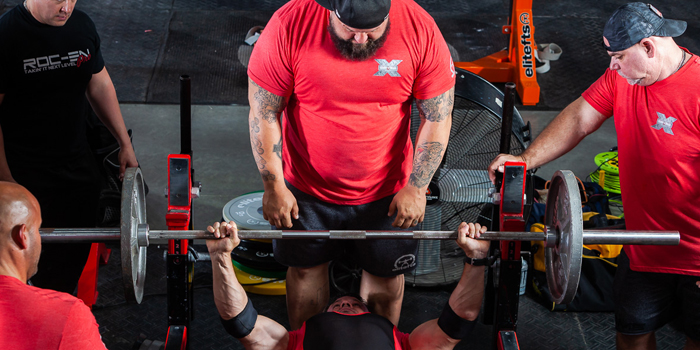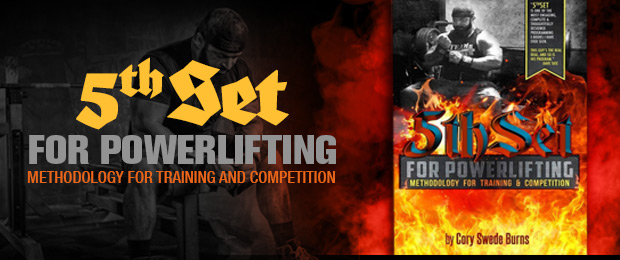
I can’t exactly say when I wanted to bench 600 pounds. If I’m real with myself, it was probably as soon as 500 pounds got racked; that's how I'm wired. Over the years, it got better and better, and soon I was opening with over 500 with competition commands. 525, 551, 560, 565, 570.
In the gym for two years straight while peaking, I hit 585, and it hit me: I’d been using the same blueprint that goes to 500 to get me to 585, and that's where I went wrong. I had to analyze myself, my training, and my recovery, and customize a new plan to break that 600-pound barrier. This is how I did that.
RECENT: JP Carroll Takes Second Place at the 2019 XPCs
I ran a linear progression style training program consisting of six microcycles (weeks) to form one mesocycle.
Here’s a layout of a typical meso for a 585-pound peaked bench:
Week 1: 415 pounds with 4 doubles and 18 on my 5thset
Week 1 Secondary Bench Day: 310 pounds for two sets of 25 wide grip
Week 2: 420 pounds with 4 doubles and 17 on my 5thset
Week 2 Secondary Bench Day: 315 pounds for two sets of 25 wide grip
Week 3: 425 pounds with 4 doubles and 15 on my 5thset
Week 3 Secondary Bench Day: 320 pounds for two sets of 25 wide grip
Week 4: 430 pounds with 4 doubles and 14 on my 5thset
Week 4 Secondary Bench Day: 325 pounds for two sets of 25 wide grip
Week 5: 435 pounds with 4 doubles and 13 on my 5thset
Week 5 Secondary Bench Day: 330 pounds for two sets of 25 wide grip
Week 6 would usually be a deload; I went right into peaking while fatigued.
So Week 6 was my first heavy single at 535 pounds. Next single was 550, and the following week, I hit 585.
Accessory Work:
- 1-Inch Pause Press (5-second pause, comp grip): 2 sets of 5 reps: use 65% 1RM. This work is linear as well.
- Side Raises: 2 progressive sets of 10 reps.
- Rear Raises: Same directions and volume as Side Raises, except these were 12 reps.
Secondary Bench Day Accessory Work:
- Rolling Tricep Extensions: 2 progressive sets of 12-20 reps.
- Cable Tricep Extensions: 2 sets of 25 reps each arm, overhand; followed by two sets of 25 reps each arm, underhand. Use the same weight on all four sets.
- Banded Pull Aparts: 3 sets of 30-35 reps, 60 seconds rest between sets. Moved to 45 seconds rest after two weeks, then upped the reps to 35 with 60 seconds, then 35 reps with 45 seconds, then added a 4th set and followed that pattern, I never did more than four sets.
After two years, the linear style of the main movement was working well. I was getting good at the movement. The thing I neglected was the adaptation to the accessory work. I got good at benching but had weaknesses that only showed up when maxing. If you only max once or twice a year, it’s hard to dissect weaknesses and adjust accordingly. Everyone feels excellent at 70 to 80 percent.
So I needed a way to find weaknesses without taxing myself. I also needed to get stronger at my lockout. I was nasty off the chest, but the transition into tris is what was failing on max attempts.
WATCH: Learn to Train X — Dave Tate Teaches the Max Effort Method
In my next benching cycle, I incorporated a speed day on my second day.
As a guideline, I was between 50 to 65 percent. It was speed-based. If I felt snappy and fast, I'd go a little more; if I was feeling sluggish and off, I’d tone it down. A thing I see is people’s speed day being atrocious.
A speed day would look something like this:
- 315 pounds 9x3 with about 60-75 seconds of rest.
- I’d leave my camera running the whole time, and that's when the magic happened.
- My lats, my shoulders, and tris would fatigue, and I could see for the first time precisely what I had to correct.
So with that information, I added a fuck ton more of direct back work. I adjusted my accessory work, and after talking to Dave, I would wave speed and lockout training (65 percent plus a couple hundred pounds in chains with a Shoulder Saver).
OK, so now I did my research, I got my info and came up with a plan, all on my own — that should be a significant takeaway.
Here are my seven weeks leading up to the Arnold:
Week 1: 425 x 2 x 4 and did 5 on my 5thset I was capping these ‘cause I was having pec issues and didn't want to stress them more than I needed too. My mechanically similar movements were 315 with the Red Shoulder Saver Pad for two sets of 15 close grip. My accessories were weighted push-ups, heavy triceps, and heavy back work. I finished every workout with 100 reps of heavy rear delt flyes.
Week 1 Secondary Bench Day: Speed work at 50-65% for 3x9. My accessories were the same as main bench day, except I moved the weight down and went with higher rep ranges to build up endurance.
Week 2: 430 x 2 x 4 and final set of 5. Mechanically similar movements were 315 with the Red Shoulder Saver Pad for 2 x 15. Again, weighted push-ups, heavy triceps work, heavy back work, and still finished with 100 heavy rear delt flyes.
Week 2 Secondary Bench Day: Repeated my speed day and speed day accessories were lighter and higher reps again.
Week 3: 435 x 2 x 4 and final set of 5. Mechanically similar movements were 325 with the Red Shoulder Saver Pad for 2 x 15. Again, weighted push-ups, heavy triceps work, heavy back work, and still finished with 100 heavy rear delt flyes.
Week 3 Secondary Bench Day: Repeated my speed day, and speed day accessories were lighter and higher reps again.
RELATED: 5 Tips That Will Increase Any Lift
Week 4: 440 x 2 x 4 and final set of 5. Mechanically similar movements were 325 with the Red Shoulder Saver Pad for 2 x 15. Again, weighted push-ups, heavy triceps work, heavy back work, and still finished with 100 heavy rear delt flyes.
Week 4 Secondary Bench Day: 325 for two sets of 25 and switched the speed work for heavy Jm presses with a Safety Squat Bar 455 x 5 x 2. Followed that with 100-pound weighted push-ups 15 x 4, incline close grip press 315 x 8 x 4 triceps work, and heavy back work.
Week 5: 445 x 2 x 4 and final set of 5. Mechanically similar movements were 325 with the Red Shoulder Saver Pad for 2 x 15. Again, weighted push-ups, heavy triceps work, heavy back work, and still finished with 100 heavy rear delt flyes.
Week 5 Secondary Bench Day: 325 for two sets of 25, heavy Jm presses with a Safety Squat Bar 475 x 5 x 2. Followed that with 100-pound weighted push-ups 15 x 4, incline close grip press 315 x 8 x 4 triceps work, and heavy back work.
Week 6: I took my first heavy single, and 535 pounds moved easy. Mechanically similar movements were 325 with the Red Shoulder Saver Pad for 2 x 15. Again, weighted push-ups, heavy triceps work, heavy back work, and still finished with 100 heavy rear delt flyes.
Week 6 Secondary Bench Day: 325 for two sets of 25, heavy Jm presses with a Safety Squat Bar 505 x 8. Followed that with 100-pound weighted push-ups 15 x 4, incline close grip press 315 x 8 x 4 triceps work, and heavy back work. Jesus, my elbows were destroyed by this point, but everything felt like I could throw 600 pounds through the roof.
Week 7: I benched 575 — and then finally, 600 fucking pounds, and it was easy.
The best part of this is that I did this all by myself; I figured it all I out. Sure, I had help from Swede, Dave, and even Vinny got the text messages, and the best thing about all three of these people is that they set me up to figure it out on my own, gave tips and suggestions, but ultimately, they left it up to me to decide what I needed to do, and I did. Unfortunately, I didn't bring it to the platform; this shit is chess, not checkers, so back to the drawing board.
Equipped with experience and the knowledge to train and program myself, I'm well on my way to become a better powerlifter, thanks to always trying to learn and accepting that sometimes you have to change the things that you think are working, and never being comfortable; being comfortable is the death of progress.











1 Comment